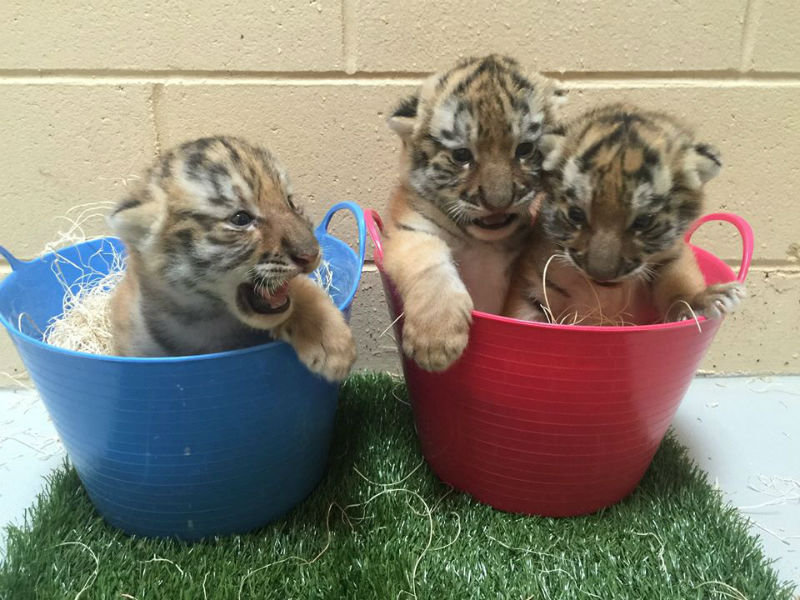Every zoo has a celebrity and those who grew up in Milwaukee during the '60s, '70s and '80s most likely remember the Milwaukee County Zoo's famous gorilla, Samson. The iconic ape fascinated and terrified zoo-goers with his erratic behavior that ranged from what appeared to be extreme boredom to pounding against the glass window of his "cage."
Samson, who died of a heart attack in 1981, continues to be Milwaukee's most celebrated zoo resident of all time. During his lifetime, large crowds surrounded his tiled stall every day and he appeared on television, in magazines and even on a Milwaukee bus pass.
Samson, a silverback gorilla, was brought from Africa to the Washington Park Zoo, which preceded the current zoo, in 1950. He was about a year old at the time and arrived with another young gorilla, Sambo, who died exactly one month after arriving in Milwaukee.
Samson went on to live alone for 16 years before he was presented with a female roommate, Terra. The gorillas lived together for four years, but never mated. Terra was eventually moved to the Lincoln Park Zoo in Chicago where she became pregnant.
The combination of Samson's glass pounding, imposing presence, expressions that some interpreted as boredom and lack of interest in sex made some people speculate that Samson was bored, angry and depressed due to isolation and poor living conditions.
Kelly Frohs, a cartoonist living in Seattle, grew up in Sheboygan and visited the Milwaukee zoo numerous times with her parents and on school field trips. As a kid, she was wowed by his largeness, but as an adult, she became suspicious of her memories of Samson.
"I think a childhood memory can be such a distorted thing," says Frohs, who wrote a zine about Samson. "Samson's strange behaviors were always chocked up to his 'personality' when in reality he was probably crazy with boredom and depression and he wanted to smash the glass to escape."
Sam LaMalfa was Samson's caregiver and best buddy from 1973 until 1981. He contributed to a book published last spring by Darlene Winters called "How I Remember Samson."
LaMalfa says Samson's living space, a tile-floored room with a glass front for viewing, was at the time considered state-of-the-art because it didn't have bars and wasn't a traditional cage. Also, for the first time, the public didn't have to smell the gorillas thanks to units separated by glass.
LaMalfa, who was very close to 16 different gorillas during his career at the Milwaukee County Zoo which lasted until he retired in 1995, believes Samson's beating on the glass wasn't out of anger. If anything, it was out of loneliness and the desire to connect with people.
"He had his share of highs and lows, like anyone, and sometimes he would get upset when he'd get teased, but he was pounding on the glass to get an audience response. He was alone, without other gorillas, so he used the public in lieu of gorillas," he says.
Samson's disinterest in mating with Terra, according to LaMalfa, was probably also the result of his lack of socialization due to isolation but also from a lack of chemistry. Like humans, gorillas have to be attracted to a mate, they can't be matched and expected to act amorous. This is one of the reasons why modern zoos do not house gorillas in isolated spaces and instead allow them to live in groups so they can mingle and find the right mate.
Most likely, Samson was not disappointed with his surroundings. LaMalfa believes, because Samson was so young when he came to the zoo that he did not remember his time in the wild. Today, animals in zoos must be bred in captivity, because of the 1973 Endangered Species Act signed by President Nixon.
"As humble as his surroundings are to us looking back – he lived in a large bathroom – he didn't know anything else," says LaMalfa. Although he was not connected to other apes, Samson was emotionally connected to LaMalfa. "He protected me," he says.
If Samson spotted friends or zoo attendants walking up to LaMalfa and raising a hand to pat him on the back or shake his hand, Samson would beat on the glass and grunt aggressively.
"I was his big yellow banana," says LaMalfa.
LaMalfa says gorillas have about 24 different sounds they make and they are able to communicate among themselves and with humans through vocal sounds and body language.
LaMalfa is also known for putting Samson, who was a vegetarian, on a diet. In 1971, Samson weighed 652 pounds. Back then there were not veterinarians on site to consult with – the zoo has two full-time veterinarians today – but LaMalfa knew Samson was overweight and slowly started to reduce his intake by a "banana here, a slice of bread there" until the gorilla lost about 100 pounds.
Even though LaMalfa was closer to Samson than anyone else – a relationship he says that was built over time, through trust – he never spent time in Samson's unit with him. It wasn't out of fear – LaMalfa stepped into many other gorilla's living spaces – but he believed Samson was so attached to him that he would try to keep him in the space with him. Forever.
"He had been alone for 16 years. If I entered, there's a good chance he would block the door and I'd be eating bananas and peanuts for the rest of my life and my wife and kids would have to visit me on the other side of the glass," says LaMalfa, joking but not joking. "Samson could be very possessive."
On Nov. 27, 1981, Dr. Bruce Beehler, the deputy zoo director, received word that Samson was possibly choking. Beehler rushed to the scene, performed CPR and a tracheotomy on Samson, but he had suffered a massive heart attack and died.
Heart problems with gorillas in captivity is an issue currently being researched by groups of scientists. The Atlanta Zoo founded the Great Apes Heart Project and the Milwaukee zoo a key partner in the project that's dedicated to determining why so many great apes in captivity have heart problems.
"This is a very large effort dedicated to determining the origin of heart issues in great apes and what can be done about it," says Beehler.
For 15 years, Dr. Victoria Clyde, a veterinarian at the zoo, performed ultrasounds on bonobos, orangutans and gorillas to find out more about the cause of the heart attacks. Genetic abnormalities, which cause heart issues in humans, might contribute to the high rate of cardiac events.
Clyde also determined the apes' food pellets contained more sodium than indicated in the analysis and got the manufacturer to reduce the amount of salt in the pellets. She also put them on a low-salt diet.
"It might also be due to stress," says Beehler. "We just don't know but all avenues are being explored."
Today, a replica of Samson stands in the Milwaukee Public Museum. After his death, Samson was stored in a freezer for three years, received what LaMalfa refers to as severe "freezer burn" and could not be taxidermied like Sambo. Instead, Wendy Christensen-Senk, the museum's full-time taxidermist, reconstructed him with LaMalfa consulting to make sure it looked like the real Samson.
"Samson was a very handsome gorilla. All gorillas have different personalities and different appearances. It's like a kindergarten teacher who sees all of her students as individuals," says LaMalfa.
Molly Snyder started writing and publishing her work at the age 10, when her community newspaper printed her poem, "The Unicorn.” Since then, she's expanded beyond the subject of mythical creatures and written in many different mediums but, nearest and dearest to her heart, thousands of articles for OnMilwaukee.
Molly is a regular contributor to FOX6 News and numerous radio stations as well as the co-host of "Dandelions: A Podcast For Women.” She's received five Milwaukee Press Club Awards, served as the Pfister Narrator and is the Wisconsin State Fair’s Celebrity Cream Puff Eating Champion of 2019.







